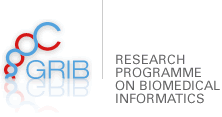
Tuesday, 24th April, 2012, 11:00-12:00
De-Novo Discovery of Differentially Abundant DNA Binding Sites Including Their Positional Preference
The identification of DNA binding sites has been a challenge since the early days of computational biology, and its importance has been increasing with the development of new experimental techniques and the ensuing flood of large-scale genomics and epigenomics data yielding approximate regions of binding. Many binding sites have a pronounced positional preference in their target regions, which makes them hard to find as this preference is typically unknown, and many of them are weak and cannot be found from target regions alone but only by comparison with carefully selected control sets. Several de-novo motif discovery programs have been developed that can either learn positional preferences from target regions or differentially abundant motifs in target versus control regions, but the combination of both ideas has been neglected. Here, we introduce Dispom, a de-novo motif discovery program for learning differentially abundant motifs and their positional preferences simultaneously. Dispom outperforms existing programs based on benchmark data and succeeded in detecting a novel auxin-responsive element (ARE) substantially more auxin-specific than the canonical ARE.
Since its publication, we have endowed Dispom with more complex motif models and extended it to handle weighted input data such as ChIP-seq or BS-seq data. We have been applying Dispom to in-house and publicly available data of different transcription factors and insulators in yeasts, plants, and mammals as well as to protein-binding microarrays, where it turned out to be one of the top-scoring approaches in the corresponding DREAM challenge.
Speaker: Dr. Ivo Grosse, Institute of Computer Science, Martin Luther University, Halle, Germany
Room Xipre (seminar 173.06-183.01)


